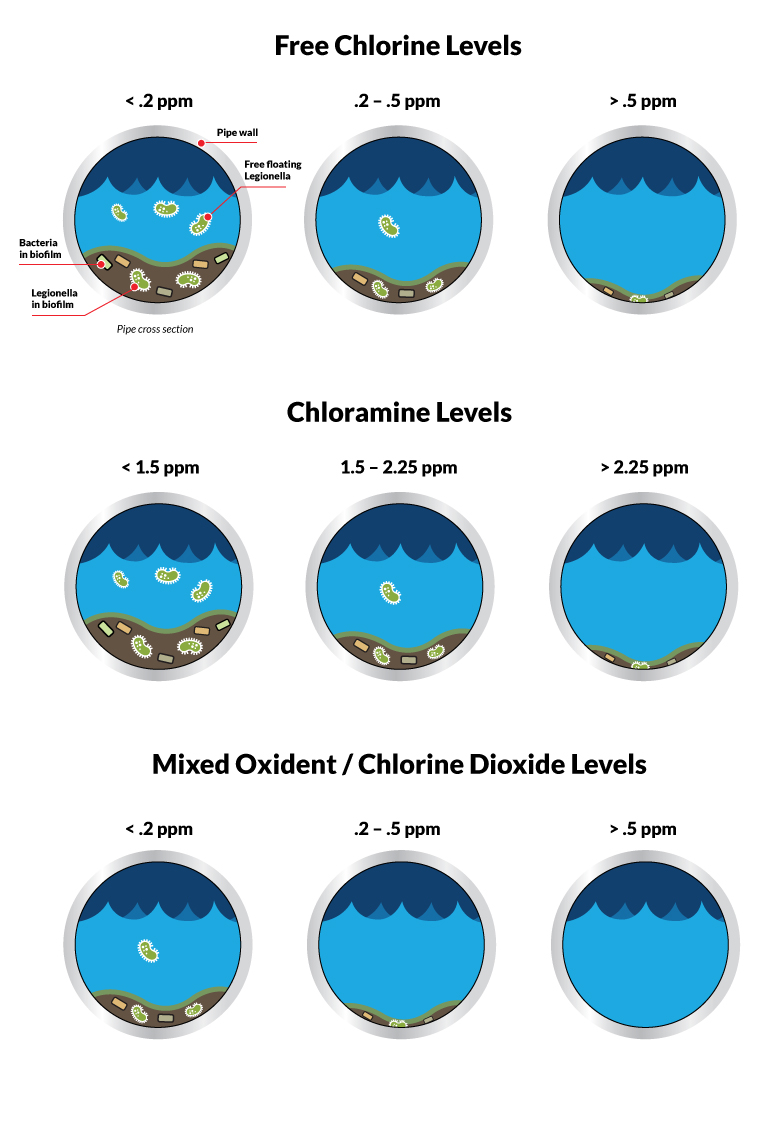Controlling Legionella with Chemical Based Disinfectants
For support regarding any of our industrial water products and services, please contact a Nancrede Representative.
Hours: Monday thru Friday 8-5 EST
Tel: +1 888-416-8626
Email: info@legionellacontrolsystems.com
Contact us for a Quote
Tel: +1 888-416-8626
Email: info@legionellacontrolsystems.com
How do you control Legionella with disinfectants? The most common ways to control Legionella and pathogens with chemicals are by injecting chlorine and monochloramines into the water. These chemicals are widely available, well understood and inexpensive. They are often used by municipalities to keep the water safe. If the water system in a facility is designed well and the other two major risk factors, water age and water temperature, are managed well, chlorine and monochloramine residual from the municipality will often suffice to keep a building safe.
Often, this isn’t the case. Plumbing codes have not kept up with water conservation efforts nor new, high efficiency fixatures, which often result in plumbing being oversized. Predicted water consumption is often much higher than actual consumption, which leads to water stagnation and dangerously high water age and low disinfectant levels in the water.
How much disinfectant is needed to keep the water safe from Legionella? There isn’t a uniformly agreed answer to this, but most experts agree that some level of disinfectant is needed all the way to the taps, or wherever the water is going to exit the plumbing. See our Chemical Demand Calculator for Legionella.
 |
Chemical Demand Calculator for Legionella |
The most common secondary chemical disinfection methods are:
- Chlorine
- Monochloramines
- Chlorine Dioxide
- Mixed Oxidant Solution (MOS)
- Advanced Oxidation Process (AOP)
Regardless of free chlorine (sodium hypochlorite) level, biofilm often still forms. Chlorine is not effective in removing or preventing biofilm. Over 90% of Legionella and other pathogens are found in biofilm, so removing it is critical to eradicating Legionella. Mixed oxidants (MIOX) and chlorine dioxide systems for Legionella control are much more effective at removing biofilm and preventing it from forming.
 |
What is the difference between secondary disinfection and supplemental disinfection? |
Water can also be filtered and disinfected without the use of chemicals. Some of these methods remove Legionella, pathogens and their food sources. Meanwhile, other methods, like Copper Silver Ionization, prevent the pathogens from reproducing or can kill them to keep water safe. All non-chemical modalities to combat pathogens and Legionella can be seen here.
Legionella / Pathogen Control with Chemical Disinfectants
Want to keep your customers, patients and employees safe? Contact Legionella Control Systems at info@legionellacontrolsystems.com or 888-416-8626 for Legionella testing, control systems, disinfectant systems, engineering design, consulting and sales in Indiana, the Midwest and throughout the U.S.
Contact Legionella Control Systems for CDC Legionella risk assessment and Legionella testing.








